dev.stationaryreality.com
The Engine
 Site Updates
Site Updates
Site updates and dev notes — last entry: June 21, 2025. Track ongoing work, fixes, and content restructuring across the site.
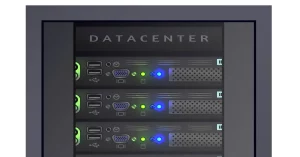 Virtual Private Server
Virtual Private Server
An overview of setting up, securing, and maintaining a self-hosted VPS as the foundation of the site.
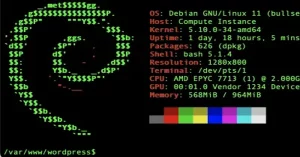 Linux Server Configuration
Linux Server Configuration
Covers key Linux setup tasks, from system updates to service management, forming the backbone of server operations.
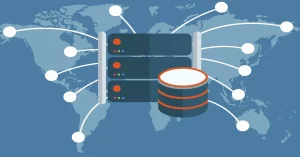 DNS & Content Delivery
DNS & Content Delivery
Explains how DNS, SSL, and CDNs like Cloudflare optimize site speed, security, and worldwide accessibility.
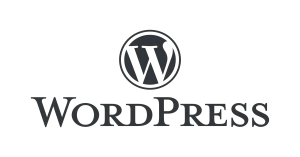 WordPress Content Management
WordPress Content Management
How WordPress evolved from a casual setup into a structured, scalable content management system.
 GitHub: WordPress Customization
GitHub: WordPress Customization
Custom WordPress code and tweaks hosted on GitHub. Click to view my open-source customizations and plugins.
 Security & Hardening
Security & Hardening
How I configured my site’s security layers, including firewalls, plugin choices, and practical hardening steps to protect against common attacks.
 Performance & Optimization
Performance & Optimization
Covers the tools, techniques, and strategies I use to improve my site’s speed, response time, and overall performance, both on the front end and server side.
 Media Handling & Image Strategy
Media Handling & Image Strategy
Outlines my approach to organizing, optimizing, and integrating images across the site—balancing performance, quality, and long-term maintainability.
 Content Structure & Taxonomy
Content Structure & Taxonomy
A dynamic framework connecting people, ideas, and media through structured tags, custom fields, and semantic relationships across the entire site.
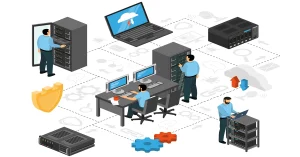 Backup Strategies & Recovery
Backup Strategies & Recovery
A concise overview of backup approaches, tools, and recovery planning to protect your site from data loss and downtime.
 Contact Systems: Email & Forms
Contact Systems: Email & Forms
Covers how contact forms and email systems are configured to ensure reliable communication and secure message delivery.
 Using AI in Site Development
Using AI in Site Development
Leverage AI to streamline tasks like content creation, SEO, and image generation, enhancing site development speed and consistency.
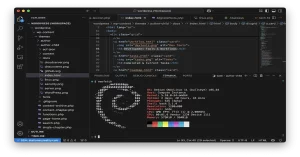 Development Tools & Workflows
Development Tools & Workflows
Covers the tools and workflows used to manage, develop, and maintain the site, including Obsidian, VS Code, Git and WP-CLI.
Current Tasks
 Current & Future Tasks Overview
Current & Future Tasks Overview
An overview of current projects, active maintenance, and upcoming improvements planned for the site.
 Create Custom Footnotes System for Chapters
Create Custom Footnotes System for Chapters
I need to find a way to reproduce the Wordpress footnotes system in Custom Post Types.
 In Progress: Convert All Cover Blocks to WebP Images
In Progress: Convert All Cover Blocks to WebP Images
This taks is very annoying and will take some time, probably months. But it is essential for my task of ACF Pro custom field integration.
 Migrate VPS From Apache to NGINX
Migrate VPS From Apache to NGINX
My sites are currently using Wordpress on Apache. It is more efficient on a low-end VPS to use NGINX.
 Modify Tag System at Bottom of Chapters
Modify Tag System at Bottom of Chapters
At the bottom of chapters, it shows all the chapters associated tags. I want to fix this area to be more specifically controlled for use with future ACF Pro field integration.
 Create CSS Style for Cover Block Width
Create CSS Style for Cover Block Width
I need to find a way to reduce the width of all cover blocks. They currently stretch beyond the main section.
 Implement Parallel Data Structure for Dynamic Content Rendering
Implement Parallel Data Structure for Dynamic Content Rendering
I want to design a parallel data structure to separate content from layout, enabling clean dynamic page rendering across all site sections.
 Fix Category Archives for Posts and Chapters
Fix Category Archives for Posts and Chapters
I just noticed that my post and chapter archives are disabled, except for uncategorized posts… Need to fix.
 Fix Navigation Glitch Where I Have to Sometimes Scroll up Twice Before It Refreshes
Fix Navigation Glitch Where I Have to Sometimes Scroll up Twice Before It Refreshes
The left navigation bar acts funny sometimes. It has a delay where it will be stuck unless i scroll up twice.
 Modify People Referenced Pages To Include Wikipedia API With Advanced Custom Fields
Modify People Referenced Pages To Include Wikipedia API With Advanced Custom Fields
I want to add a wikipedia bio to people referenced pages using wikipedia’s API and ACF Pros custom field to store wikipedia slug.
Completed Tasks
 Summary of Completed Tasks
Summary of Completed Tasks
A summary of key milestones, fixes, and improvements already completed in the site’s development.
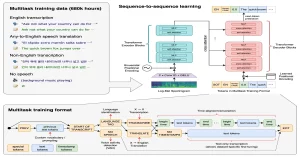 Transcribing Audio With OpenAI / Whisper
Transcribing Audio With OpenAI / Whisper
It is very easy to install Open source/free AI software locally. OpenAIs Whisper lets you convert any audio file to text locally. This allows you to keep your files private without having to upload them to a web-based transcriber.
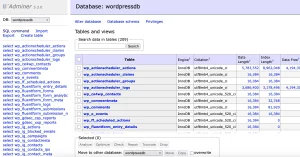 Using Adminer to Manage WordPress Database Tasks Securely
Using Adminer to Manage WordPress Database Tasks Securely
I used Adminer to safely and efficiently replace featured image extensions with .webp in the database, avoiding manual updates while preserving file paths and post associations.
 Creating a Full Disk Image Backup of a VPS Using dd
Creating a Full Disk Image Backup of a VPS Using dd
Using dd in Rescue Mode, I cloned my VPS’s disk for a full WordPress backup, ensuring bare-metal recovery.
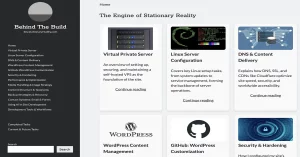 Installing a Second Instance of WordPress
Installing a Second Instance of WordPress
ChatGPT has empowered me to create a site with more advanced features than I imagined possible. I have a lot of work ahead of me…
 How My Homepage Grid Reflects My Content Workflow
How My Homepage Grid Reflects My Content Workflow
A breakdown of how my homepage grid reflects the full content lifecycle — from tasks to chapters — using dynamic WordPress structures.
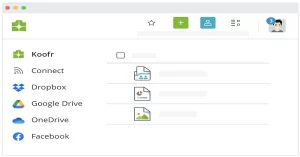 Using Koofr to Backup Chapters
Using Koofr to Backup Chapters
Free 10GB Koofr storage makes encrypted chapter backups easy with rclone. Sync folders, save logs, and automate with aliases.
 Creating WP-CLI Script To Automate Task Insertion
Creating WP-CLI Script To Automate Task Insertion
I want to find a way to use WordPress Command Line Interface to automate this task creation. That way I can simply run the script,…
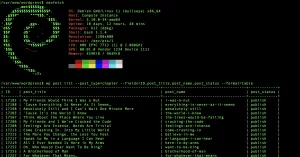 SOLVED: Figure Out Why Some Pages Are Seen As Redirects
SOLVED: Figure Out Why Some Pages Are Seen As Redirects
I recently added my site to Google search console. This tool give you insights into how Google indexes your site and if it sees any issues.
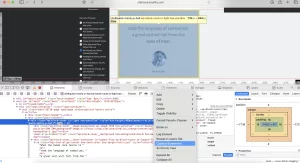 Using Safari’s Developer Tools to Create Images from WordPress Cover Blocks
Using Safari’s Developer Tools to Create Images from WordPress Cover Blocks
Learn how to turn styled WordPress cover blocks into crisp images using Safari’s built-in developer tools on macOS.
 Convert All Images to WebP
Convert All Images to WebP
I am currently converting all image to WebP format which is much smaller. This involves consolidating every image, one chapter at a time into a folder and renaming them according to my new naming convention.
 Create Custom Post Types for Artists, People Referenced & Books
Create Custom Post Types for Artists, People Referenced & Books
I created CPTs for Artists, People Referenced, and Books. I also created ta grid page and individual templates for each CPT.
Demystifying Code
 Demystifying Code: Intro
Demystifying Code: Intro
A journey into the heart of code and data—breaking systems down to their roots to master your craft from within.
 Demystifying Code: What Files Look Like in Hex
Demystifying Code: What Files Look Like in Hex
A visual tour of raw data—how hex reveals the hidden structure behind files, randomness, text, images, and code.
 Demystifying Code: The Binary Bridge
Demystifying Code: The Binary Bridge
What does your computer really see when it runs a program? Let’s peel back the layers of a simple XOR tool.
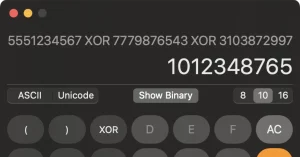 Demystifying Code: XOR Magic
Demystifying Code: XOR Magic
A single operator that can encrypt data, reverse strings, and even recover missing values? Welcome to the strange power of XOR.
 Demystifying Code: What Wireshark Sees
Demystifying Code: What Wireshark Sees
Using Wireshark, we visualize how data travels through your machine and the network — revealing encapsulation in vivid, byte-level detail.
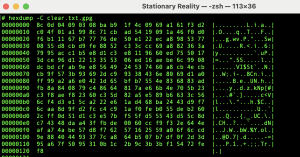 Demystifying Code: Privacy Is Now the Default
Demystifying Code: Privacy Is Now the Default
Most web traffic today is encrypted — but what does that really mean, and what does it protect you from?
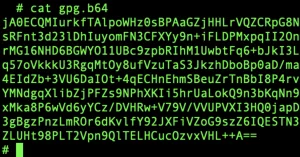 Demystifying Code: GNU Privacy Guard
Demystifying Code: GNU Privacy Guard
GPG reveals the real distinction between cleartext, encoding, and encryption — a perfect entry into the world of modern cryptography.
 Demystifying Code: When DNS Betrays You
Demystifying Code: When DNS Betrays You
Even if your web traffic is encrypted, your DNS queries may still leak what sites you visit. Here’s what that looks like—and how to stop it.
 Demystifying Code: Passwords, Hashes & Salt
Demystifying Code: Passwords, Hashes & Salt
How passwords are stored, how hashes work, and why modern systems rely on salts to slow down attackers.
 Demystifying Code: Tools That Bend the Rules
Demystifying Code: Tools That Bend the Rules
Raw tools like curl, telnet, and netcat let you explore, debug, and defy standards—revealing how systems actually behave.
 Demystifying Code: Patterns on the Wire
Demystifying Code: Patterns on the Wire
Snort, ClamAV, and YARA reveal a shared logic between antivirus and network intrusion detection—pattern matching as control, insight, and defense.
Unrelated
 The Power of Open Source: Why Linux and the Command Line Still Matter
The Power of Open Source: Why Linux and the Command Line Still Matter
I wanted to write an article on open source software, and specifically Linux. Sometimes I forget how deeply I understand these systems—and that many people…
 How a Simple Memory Setting in ChatGPT Saves You Tokens and Extends GPT-4 Access
How a Simple Memory Setting in ChatGPT Saves You Tokens and Extends GPT-4 Access
A single memory instruction can make GPT-4-turbo more efficient—just ask, and it’ll start using fewer tokens.
 Wiping Deleted Files from Free Space with dev/urandom
Wiping Deleted Files from Free Space with dev/urandom
Deleted files linger in free space. dev/urandom makes overwriting them easy. cat /dev/urandom > tmp. No paid tools needed—just raw terminal power.